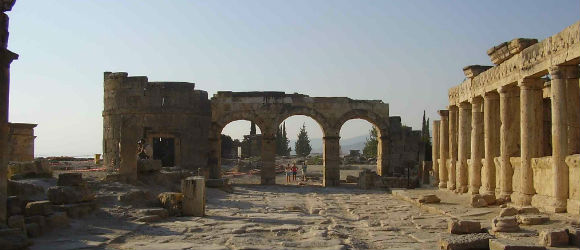The presence of a hot spring at Hierapolis and the spectacular calcium deposits from its water spilling over the nearby hillside suggest that there should be evidence of an early settlement there. The oldest Inscription found so far, however, indicates it was founded by Eumenes II, king of Pergamon, in the latter part of the second century B.C.; it soon became a busy industrial center.
Pagan worship in the city centered around Cybele, Apollo, Artemis, Men, Poseidon, and Pluto. Underneath the Temple of Apollo has been found the Plutonium, an opening in the earth from which a noxious gas still comes. The temple is between the pool where the hot spring rises and the large theater on the side of the hill. To the north along the rim of the plateau is a long avenue of tombs.
Traditionally St. Philip is connected with the early church in Hierapolis. Fairly recently Italian archeologlsts have discovered his Martyrium, an octagonal chamber forming a double cross surrounded by a square. This is almost due north of the theater, also on the side of the hill. It was a fifth century A.D. building and did not last much more than 100 years. No tomb was found with it although that was expected. There are several ruins of churches, one not far from the baths, one on the main road leading to the necropolis.
Hierapolis is listed in the New Testament along with Laodicea as the center of Epaphras’s work (Colos-sians 4:13). This was at the time Paul was writing to strengthen the message Epaphras was preaching and to condemn the “people who go in for self-mortification and angel-worship” (Colossians 2:18). Another less well-known resident of Hierapolis was Papias, a disciple of St. John and the author of the lost book called the Sayings of Jesus.
While Epaphras was is that area, a young slave was growing up in Hierapolis, a boy whose original name is unknown but whom we call by the Greek for “Acquired”, Epictetus. In his Discourses Epictetus often talks about the perfect missionary whose bed was the ground, whose only house the earth and sky and a shabby cloak, and who must love those who misuse him in the service of God. One wonders what the influence of those early Christians, many of whom were slaves themselves, was on this Stoic philosopher.
Hierapolis,


We were staying in Antalya and we made a trip to Pamukkale to see the magnificent Roman city and the bizarre and unique limestone formations that were there. It was fantastic and really worth the 3 hour trip. Undoubtedly recommended
We spent a half day in Pamukkale at the Ancient City and the thermal pools. It was our first experience at Pamukkale and the thermal pools were interesting and are worth the time to visit. The Ancient City has wonderful ruins. They are not as preserved as at Ephesus but it is must less crowded and we found it peaceful…
good bits- unmissable. great fun
bad bits- the length of time to get there, and the unwanted tour of the marble shop.
the price is good for what you get, but the spa is extra, they never tell you this when you book, this caused a big row with a lot of the people in the group. adam budd
Nothing prepared us for this amazing experience, no wonder it's a World Heritage Site. Staff are there to ensure that all visitors remove their footwear so the white of the calcium carbonate which make up the travertines isn't soiled by dust and dirt. The ancient city of Hierapolis felt as if it was only asleep whilst the huge ampitheatre is…
This was a very interesting place. There is a line of hot springs running all along an ancient geological fault line. The spring temperatures rate from boiling to tepid. Hierapolis' springs were just the perfect temperature and have been for millenia. When you walk the old streets you can just imagine it as an ancient resort town with toga wearing…
We went here at 2:45pm at the advice of our hotel owner ( to avoid the crowds) and stayed till it was starting to get dark ( between 7 and 8 PM) and wish we would have maybe gone a couple of hours sooner as there really is a lot to see here. The ruins themself are really stunning and…
The entrance into Pamukkale has been changed to down the bottom of the site near the town so you have to take your shoes off and walk bare foot up through the site – it is a wonderful feeling under your feet and then you also have to walk through running water which is lovely. There was only one slippery…
I visited Turkey around 8 years & sat on the beach, walked around the local town & did a boat trip or 2. However this trip we did a 5 day road trip within our 10 day vacation. I spent my 40th birthday travelling to & exploring Pamukkale, which is well worth the seemingly long coach trip, unfortunately we ran…
It is an intresting place, historical + spectacular. Worth seeing and swimming in the warm water pools.
A fascinating place, very atmospheric at dusk. I particularly liked wandering through the necropolis and through the North Gate which still has portions of the original marble above the central arch. Walk through the Agora, see the drains under the street.